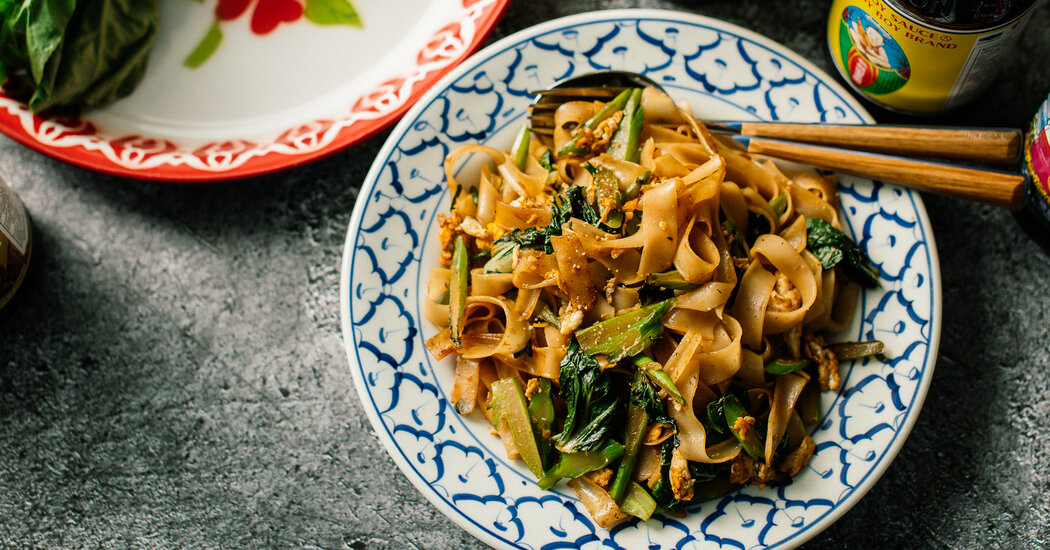
In Thailand, pad Thai, pad see ew and pad kee mao are just three of countless popular noodle dishes. But at Thai restaurants elsewhere, they are canon.
“Those are the three noodles that everyone who’s been to Thailand wants to make,” said Watcharee Limanon, who has moved between Bangkok and the United States since 1994, and built a small Thai culinary empire from her home in Yarmouth, Maine.
These dishes are especially popular, said Ms. Limanon, not only because they are widely available, extremely inexpensive and legendarily delicious. It’s also because they have built-in “rot chaat dee” — the balance of tastes (hot, sour, salty, sweet and bitter), textures (crunchy and soft, chewy and crisp) and flavors (fishy and herbal, rich and light) that Thai cooks — and fans of Thai food — appreciate.
“You know how caramel cheese popcorn is a perfect food?” said Pailin Chongchitnant, a chef in Vancouver, British Columbia. “The sweet makes you crave salt, and the salt makes you crave sweet.” In Thai, she said, “glom glom” is the term for that can’t-stop-eating-it quality.
“That’s what a really good pad see ew is like,” she said.
Even for expert Thai cooks, getting these dishes just right in a home kitchen doesn’t come easily. Noodle stir-fries are classic street food, cooked to order by vendors who can wield giant woks and dip into dozens of bowls of ingredients. But for those who live abroad, home cooking is often the only way to satisfy their cravings. (Thai restaurants outside Thailand, for many reasons, rarely cook food to Thai tastes.)
As a longtime seeker of perfect stir-fried noodles, I asked Ms. Limanon and other cooks how they adapt these dishes for their own kitchens, with local ingredients, appliances and challenges.
First off: A wok isn’t always the right tool for the job.
The tiny Manhattan apartment that the chef Hong Thaimee first moved into had a tiny stove without a single powerful burner. So she long ago started using her robin’s-egg-blue Dutch oven for stir-fries.
“Even if you can get a wok hot enough to sizzle, adding the ingredients cools it way down,” she said. “What you need is a pan that holds onto heat,” with a flat bottom that comes into direct contact with the flame. (Thai noodle vendors often use flat woks, for the same reason.)
Pad kee mao, often translated as “drunk noodles,” belongs to a larger family of “kee mao” dishes, all with the same potent combination of garlic, chiles and basil, good for late-night cravings — and possibly hangover prevention.
When balancing these big tastes, she said, every home cook follows his or her own “rot meu,” or “hand flavor.” Your uncle might have a heavy hand with pungent garlic and hot chiles; your mother might lean toward sweet basil and coconut vinegar. “There’s never just one recipe,” she said.
Although finding “authentic” ingredients can be a challenge, insisting on authenticity is often counterproductive, said Ms. Chongchitnant, who posts detailed recipe videos on her popular YouTube channel, “Hot Thai Kitchen.”
“People in Thailand are always playing around with the recipes anyway,” she said.
Ms. Chongchitnant grew up in Hat Yai, near the southern border with Malaysia, where she ate pad see ew made with egg noodles instead of the standard rice ones; later, the family moved to Bangkok, where restaurants advertise their use of spaghetti and linguine. Although the original dish is made with beef — it’s related to Chinese chow fun — she said that chicken and pork are just as popular in Thailand.
In North America, if she can’t find gai lan, Chinese broccoli, she uses broccolini (a hybrid of gai lan and broccoli), or cuts broccoli into long florets, because the crunch of the thick green stems is what the dish needs.
“People assume that a good substitute for an Asian ingredient is another Asian ingredient,” she said, noting that bok choy and Napa cabbage are often suggested — unhelpfully, in her view — as good substitutes for gai lan. “That’s not always true.”
Similarly, she said, non-Thai cooks often assume that the best substitute for holy basil is Thai basil — but Italian basil is often a closer flavor match.
Jam Sanitchat has a restaurant in Austin, Texas, called Thai Fresh, that also functions as a cooking school, a market and a vegan ice cream shop. She said that on principle, despite demand from vegan and vegetarian locals, she couldn’t bring herself to make pad Thai entirely without fish sauce.
“I refused for a long time,” she said. But eventually she decided that the central role of condiments — the ubiquitous fish sauce, chili powder, lime wedges, pickled chiles and more — proves that in Thailand, taste is sometimes more important than tradition.
“A French chef would never let you season his food,” she said. “We are much more open to choice.”
Understanding ingredients can be a challenge, especially for cooks who are unfamiliar with, say, the entire array of Asian soy sauces. Thai black soy sauce has a complex umami sweetness; some brands of Chinese black soy sauce are a good match for it, but others are much more salty. The solution, Ms. Sanitchat said, is to always season lightly, then taste.
A sauce that has tipped over into excess saltiness can be corrected with brown sugar. A too-spicy dish might be asking for a pinch of sugar, or the tartness of tamarind, lime or even straight vinegar. (Modern cooks in Thailand often use distilled vinegar, but the traditional product is made from coconut water.)
Sometimes home cooks have to adjust their cooking to someone else’s taste. “My kids won’t eat anything with dried shrimp in it,” said Yaowalak Good, who lives in Boise, Idaho.
She and her husband, Jerry, run ImportFood, one of the country’s biggest distributors of Thai staples and fresh produce like lime leaves, holy basil, lemongrass and bird’s-eye chiles, all grown on West Coast farms. So, she said, she simply uses fresh shrimp — as many cooks in Thailand have always done, especially along that country’s long coastline.
Ms. Limanon, who runs Thai cooking classes from her home, guided me through making pad Thai (she uses a nonstick skillet).
Before the cooking even began, I learned something immeasurably useful: When using dried rice noodles for stir-fries, no matter what the package says, you should never boil them. To stay soft and springy, not mushy, they need to soak in hot water until about 70 percent of the way to being done.
Although pad Thai is the national dish, it is a recent addition to culinary tradition.
Thailand has its own rich and ancient cuisine, but the technique of stir-frying noodles entered the repertoire from China. Pad see ew and pad kee mao have been popular for generations, but retained an identity that was separate from traditional Thai cooking.
After a 1932 coup that shifted the Thai government from an absolute to a constitutional monarchy, and a period of devastating rice shortages, the new regime made a push toward nationalism, efficiency and public health. These dovetailed into the official ordination of a new, fully Thai, national dish. Chinese soy and oyster sauces were replaced by fish sauce. The other ingredients chosen were all native to the country (fish sauce, peanuts, palm sugar), shelf-stable (dried shrimp, tamarind) and affordable (rice noodles, cheaper than rice per serving).
Today, there are countless variations of pad Thai around the country. Ms. Limanon’s favorite, fragrant with shallots and garlic, is adapted from a recipe once used in the royal palace (or so she was told by her cooking teacher). Some popular versions are colored deep orange by the innards of shrimp and crabs, or spiked with red chile powder. Each serving of pad Thai hor khai, made by the deftest street vendors, is wrapped in a silk-thin omelet.
The regime that came to power in 1932 did not last, but the recipe did. It has rot chaat dee.
“The people would never have adopted it so enthusiastically otherwise,” she said.
Recipes: Shrimp Pad Thai | Pad See Ew | Pad Kee Mao (Drunken Noodles)




